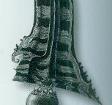|
Badawa is a traditional weapon like a Pedang. It is 20 to 22 inches (50 to 55 cm) long and 2 to 3 inches (5 to 8 cm) wide. It has the shape of a Golok and one side of the blade is sharp. In earlier times a Badawa has been used only by officials in the Keratons (palaces) on the island of Java.
|
|
B |

|
Badela is a pamor. It belongs to pamor Tiban. The magic power is less good. The pamor can be found at the Sor-Soran. Since the magic power is negative, krisses be discarded with this pamor or placed in a museum.
|

|
Badek Patani is a traditional weapon, which was built in the Kerajaan Pathani and Surathani. One finds this weapon also in parts of Southern Thailand. The shape looks almost like a Badík Bugis or Luwu in Sulawesi. The only difference is in the part at the end of the blade. This Badík is also like a keris of iron produced, has a pamor and is between 8 and 9 inches (20 and 23 cm) long (without handle). Usually there is therefor also a sheath, which is often studded with gold or silver. The handle is then usually set with jewels. Unlike Badík Bugis Makassar or outweighs the part of the blade is without pamor. The blade is thicker than a Badík from Indonesia. In the territories indicated that Badek Patani is worn to complete the clothes specifically in a substance Sarung before the stomach with the handle towards the right. This Badík is no longer manufactured after the defeat in the Pacific War in the year 1941.
|
|
Badik is a traditional weapon of Sulawesi. This weapon is used by ethnic Bugis, Makassar, Goa and Luwu. It is a knife with a sharp side and although the front. The tip of the blade is sharp. The handle is made of wood, ivory, bone or horn. The scabbard is made of wood, usually Trembalo wood. Today one often finds even sheaths of plain wood. As the keris is the iron blade. The pamor is pamor Luwu and contains star stones, the Titanium. Therefore, the blade is protected against rust and strong. Many kriss lovers believe that a Badík has mysterious force and an advantageous effect for personal possession. Normally one finds pamor Miring. Motives are often pamor Adeg and Kol bunts. The magical power is to ward off storms and is therefore suitable for seafarers. The Badík also serves the completion of the clothing and the fabric is worn as a Sarung on the front side of the stomach with the handle towards the right. There are two types of Badík, Badík Saroso and Badík Pateha. Badík Saroso has a wooden sheath often decorated with silver and is a Pusaka weapon. The Badík Pateha has no pamor and the sheath is made of leather or plain wood. Therefore, this Badík is often used for cutting. Previously the Badík in South Sulawesi was used to defend for duels between men for the honor and good name. They were tied with one hand to each other, then the other was to fight. Many people from Bugis, Makassar and Goa went traveling and then the Badík in Southeast Asia has spread, the people of Malaysia, Brunei, Philippines, Singapore and Thailand know the Badík. They also use the word Badík except in Thailand the people say Badek. Perhaps because the shape is so beautiful that Badík was also made many centuries ago by EMPUS in Java.
|
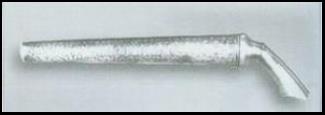

|
2 Badik with different handles |
|
Badik Saroso Badik Pateha |
|
Badkiruna is a Tombak from South Borneo and East Borneo. The spearhead is thin and flat, and approx. 14 inches (35 cm) long. The handle is made of wood with covering of rattan and approx. 6 - 7 feet (2 meters) long.
|
|
Bakung is the name of a Dapur of a keris with 5 Luk. Bakung is the plant Crinum (Amaryllidaceae). This Dapur has Pejetan, Tikel Alis and Greneng. The Gandik is simple. Other parts of the Ricikan you will not find in this Dapur.
|
|
Balatu is a traditional weapon of Nias, Sumatra. It has the shape of a Pedang and is approx. 27 inches (70 cm) long and 2 inches (5 cm) wide. Earlier this weapon was used for warfare. The used wood is very hard and it is also used an ornament horse hair. The scabbard is made of wood and wound with rattan.
|

|
Balebang is a traditional weapon of Nias, Sumatra. It has the shape of a Pedang and is approx.27 inches (70 cm) long and 2 inches (5 cm) wide. Earlier this weapon was used for warfare. The wood used is very hard and is used as an ornament horse hair. The scabbard is made of wood and rattan wound.
|
|
Bali is a famous tourist island in Indonesia and a Keris center. There you will find krisse with a blade length of 15 inches (40 cm) and a little more. Before the 17th century krisses had the form of Majapahit keris, as the nations on the road to the east came to Bali and brought the keris. Then it got another form. There were not only changed the handles. This independent keris shape is now as follows: The blades have a length of 15 - 18 inches (39 - 45 cm) and a width of up to Ganja reached 4 1/2 inches (11.8 cm). The Warangkas are also designed much larger and longer than with a Java Keris and more elaborate. The most common forms are Kekadikan, Godohan and Kojongan. But the pamor motives agree nor with the pamor motives in Java as such. e. g. Sungsun Buron, Tunggul Kuks, Wos Wutah, Tepen (Wengkon) or Bendo Sagodo. Since the presidency of Suharto the guests of honor Bali krisses were given as a gift.
|


|
How to wear a keris in Bali |

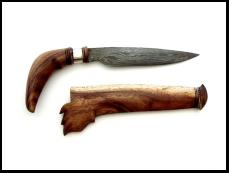

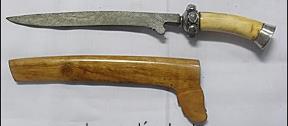
|
Balong is the "head" of a handle of the models Anak Ayam Jawa or Demam called and stylized a bird. In Bugis these models are also known as Hulu Burung (Bird handle).
|
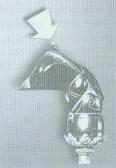
|
Balusi or Baluese is a shield from Nias. It is built of hard but light wood. There are usually only the colors black, red and white used.
|

|
Bancean is a form of warangka and an intermediate piece between Gayaman and Ladrang. Due to the appearance but it is often associated with the warangka Gayaman and called Gayaman Bancean. Build quality is average. This type is often used by Wayang players for the stories of wayang (Tokoh) "Cakil".
|

|
Bandol is a kind of Padang Sabet with a sharp side and a sharp point. This Pedang is wider at the top than at the haft. Therefore, the weight at the top feels even heavier than the other. The length is 33 - 40 inches (85-100 cm). It's heavier than a normal Pedang Sabet and the users must be cautious when using it.
|

|
Bandotan is a Dapur for a Tombak with 7 Luk. The top is flat and dull. The Luk begin only after 1/3 of the blade length. It also takes place a Naga (Dragon) at the haft. The blade has an Ada-Ada. In the Keraton (palace) of Surakarta there also called some krisses with 11 Luk Bandotan. The Ada-Ada clearly appears, that gandar is simple, Tikel Alis and Sogokan are available, but no Greneng.
|

|
Bangkekan is a part of a tombak. It indicates the form in the middle of the blade and looks like a dent, or a belt. If it fails very slim it is called Mbembeng otherwise Mbangkek. The form is only found in Tombak with a straight blade.
|

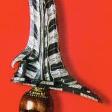
|
Bale Kencana is a Dapur of a keris with 9 Luk. The translation means "building" or "genteel palace".
|
